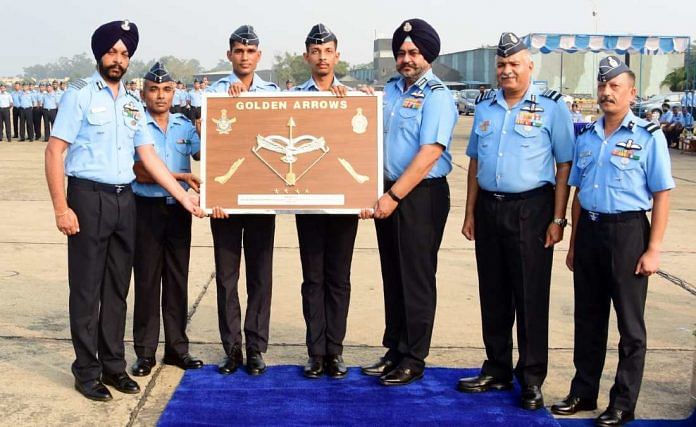New Delhi: Come Wednesday, the Ambala air base will become home to the first five Rafale jets from France, which will be inducted into the IAF’s 17 Squadron, aka “Golden Arrows”.
With the arrival of the Rafale fighter jets, the base will host three fighter squadrons. The two others are Jaguar squadrons.
The air base at Ambala is the IAF’s oldest, and is steeped in history as well as deep strategic importance. From the 1947-48 war against Pakistan, to Kargil, and last year’s Balakot air strikes against a Jaish-e-Mohammed training camp, the base comes up repeatedly as one turns through the pages of Indian military history.
Air Vice-Marshal Sunil Nanodkar (Retd), who served a years-long stint at the Ambala air base as commanding officer of a Jaguar squadron, said it has seen many “first” inductions.
“Whether it’s the French Mystere aircraft, the first two squadrons of the Jaguar aircraft, or even the first MiG-21 Bison squadron, and now the Rafales, they were first inducted at Ambala,” he added.
Also Read: Rafale jets just the latest — Indo-French fighter aircraft love affair dates back to 1953
‘Good reach and safe too’
Nanodkar said the Ambala air base is strategically important because it offers good reach towards the western and northern borders and, at the same time, is far enough inside to escape surveillance by adversaries.
“It also has a vast training area for peacetime, which is adequately displaced from borders to be monitored by our adversaries,” he added.
“The fighters stationed there can be utilised anywhere, anytime without the need to move them anywhere. The air base is also located at an adequate depth from the enemy, so the assets and other infrastructure associated with it can be protected,” he said.
Another senior IAF officer noted that the Ambala air base has been a contributing base for many operations.
“The base has technical facilities, which has a force-multiplier effect on the war-fighting capability of the IAF. It has a robust infrastructure colocated with the Army’s 2 Corps HQ, thus, there is a good synergy with the Army,” the officer said.
In the pre-Independence days, the Ambala air base served as the headquarters of the Royal Air Force’s India command. In the 1930s, it housed No. 1 Squadron, the first IAF unit. The unit was initially raised at Karachi, but moved to Ambala after the Army-IAF operations against a tribesmen uprising in the erstwhile North Western Frontier Province.
Initially, only aircraft such as De Havilland 9A and Bristol F2B operated out of Ambala, but it was made a permanent air base on 18 June 1938.
In the 1947-48 war between India and Pakistan, the Spitfires and Harvards flown by instructors of the Ambala-based Advanced Flying Training School took part in operations at Srinagar. Ambala also operated aircraft such as Vampires, Toofanis, and Hunters in a combat role.
During the 1965 war, Pakistan attacked the air base with B-57 bombers, but only a church located inside sustained damage.
Flying Officer Nirmal Jit Singh Sekhon, flying Gnats with the No. 18 Squadron — which was initially stationed in Ambala — was posthumously awarded the Param Vir Chakra after helping repel a Pakistan Air Force attack on the Srinagar air field on 14 December 1971.
The base also played a critical role during Operation Safed Sagar, or the air operations in the Kargil battle, and the 2001-2002 India-Pakistan military stand-off known as Operation Parakram.
The Jaguars were deployed to help the IAF conduct long-range photo recce to keep track of the Pakistan army’s deployment during Operation Parakram.
During Safed Sagar in 1999, Jaguar fighters from Ambala flew multiple bombing sorties, besides undertaking strategic photo recce missions.
When the IAF’s Mirage 2000s entered Pakistan to launch an attack against the JeM last year, the Jaguars were flown from Ambala towards Bahawalpur to distract the Pakistanis.
The base is home to a shrine dedicated to the Sufi saint Pir Baba, and personnel posted there believe it protects them during all major operations.
Waiting for a year
The Rafales took off from Merignac in France Monday and will reach the IAF’s Ambala air base Wednesday noon, after a halt Tuesday at the Al Dhafra air base in the UAE.
Sources in the IAF said the air base had begun infrastructural preparations to receive the Rafale jets a year ago.
Discussing the possible upgrades, an IAF officer said it would “well include avionics labs, creation of upgraded hangars with modern facilities, climate-controlled hardened storage for the special weapons packages that will come with the jets”.
Also Read: For quick deployment of Rafale, IAF opts for HAMMER weapon system, not Israeli Spice 2000




Checked the India Map. Ambala cantonment is not very far from the border. Better guard these five Rafales carefully. One can never trust Pakistanis not to make a daring attempt to destroy them.